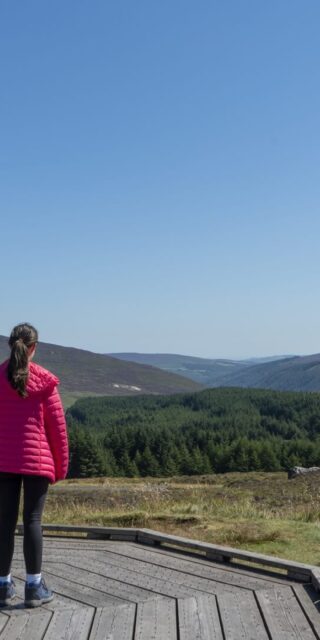Wicklow Way Stage 2
Distance:18.5km (approx.)
The first two kilometres of the route bring you through beautiful deciduous forests and across the Knockree River, but we start our first climb of the day through Crone Woods. As we climb high the track narrows and as you look to south views of Irelands highest waterfall: Powerscourt come into view.
As we leave the forest and access the open mountain, the route descends steeply to reach the Glensulan River before the rivers drops dramatically over Powerscourt Waterfall. (there is no access to the waterfall from the Wicklow Way). Our climb continues along stunning open mountain path as we traverse around the summit of Djouce Mountain. As we pick up the boardwalk we remember the plane crash 1946 which occurred just a few 100m to the west.
The JP Malone memorial is our next point of interest with stunning views over Lough Tay, the ‘Guinness Lake’ The remainder of the route is relatively easy with only short climbs and great views to the east over Wicklow and the Irish Sea.
Knockree:
You have reached Knockree when you reach the road head. A small informal carpark and a spray-painted sign on the road indicating the direction to Knockree hostel nearby are the only indicators that you have reached the end of this stage.
Knockree Youth Hostel is located just a few hundred metres from the end of this stage of the Wicklow Way with a congratulatory sign above the door to welcome Wicklow Way walkers. Located about 5.5km from Enniskerry Village. Internet access, but limited WiFi and mobile phone coverage due to the location.
Exit Point 3 – Crone Wood Car Park:
Popular car park for hikers. Distance from Crone Wood to nearest villages, Enniskerry or Kilmacanogue: 7km (approx.)
Distance walked on this stage so far:
Stage 1: N – S: Distance walked from Knockree: 2.5km (approx.)
Stage 7: S – N: Distance walked from Roundwood (Baltynanima Crossroads): 16km (approx.)
Transport Options:
Only option is to call a taxi or if your accommodation providers supply transport, call them. Tip: If your spoke English isn’t good and you want to book a taxi, download the MyTaxi App available for both iOS and Android devices, location services on your device will tell the driver where you are.
Exit Point 4 – Pier Gates:
Distance from Pier Gates to Roundwood Village by following the public road and signage: 5km (approx.)
Distance walked on this stage so far:
Stage 1: N – S: Distance walked from Knockree: 13.5km (approx.)
Stage 7: S – N: Distance walked from Roundwood (Baltynanima Crossroads): 5km (approx.)
For services – see Roundwood at http://visitwicklow.ie/towns-villages/roundwood/
Roundwood (Baltynanima Crossroads):
You have reached the end of this stage when you reach a crossroads of three tarmacadamed roads and a lane. At this point, you can walk straight through the crossroads to reach Roundwood Village and its’ services in another 2.5km (30 minutes). Most local accommodation providers will be happy to collect you from this crossroads if you ring ahead.
As the highest village in Ireland, Roundwood is in an enviable location surrounded by lakes, woodlands and mountains. With a range of activities from the doorstep, accommodation types and dining options to suit all budgets, it’s an ideal base for any outdoor enthusiast!
Things to do & see near here:
Roundwood Summer Festival, Mountain biking at Ballinastoe with Biking.ie, a round of golf at Djouce Mountain Golf Club, Victor’s Way Contemplative Sculpture Garden (adults only), Fishing on Varty Reservoir (licence required), Vartry Reservoir Walk.
Djouce Mountain
Pronounced ‘jowce’ Djouce Mountain boasts amazing views and is one of the highest points along the route. In 1946 the mountain was host to an amazing survival story when a French Junkers 52 with 5 crew and 21 girl guides onboard crashed into the side of the mountain. Poor weather conditions blew the plane off course. Communications with the plane was lost and it was hoped that it had returned to France. It was not until 5 hours after the crash that one of the young leaders from the group made it to the Maulin Hotel to raise the alarm. Having no idea where the plane was it took the best part a day to locate the wreckage. There were no fatalities. The crash site is located on the south spur from the summit of Djouce just above the end of the board walk.
Google Maps: 53.126353, -6.240935
JB Malone Memorial
The Wicklow Way was the brainchild of JB Malone, an avid walker and explorer. He first published his idea for the route in a series of newspaper articles in the 1960s. He was then commissioned by the national sports authority to formally design the route. His first proposal was a circular route but this was dropped in favour of a linear route. The first sections of the Wicklow Way was opened in 1980 and completed 2 years later. JB passed away in 1989, the plaque on the large boulder overlooking Lough Tay was dedicated to his memory.
Google Maps: 53.109839, -6.256144
Ballinafunshoge Woods
As the route progresses through Ballinafunshoge Woods several view points open out around use. To the east the Vartry Reservoirs can be seen just beyond the village of Roundwood. The water from the reservoirs supplies Dublin City via a large stone pipe. The lower reservoir (to the south) was completed in 1863 with the upper reservoir completed in 1923. Between them they can hold 16 billion litres of water. The reservoirs flooded many farmsteads and roads. During periods of low water some old bridges are visible. Hidden in this forest are the ruins of homesteads of farmers who were driven from their land as their landlord felt it took away from the beauty of the area!
Google Maps: 53.075243, -6.256026
Lugala/Lough Tay
The Wicklow Mountains are rich in geological history and the Lugala/Lough Tay Valley gives a fantastic perspective of the powers that created this stunning landscape. The granite that makes up a large part of the Wicklow Uplands was pushed up as molten rock. Glaciers sculpted the valleys and the view from the Malone Monument shows the immense power of the ice as it scraped its way down the valley leaving behind the bare cliffs of Lugala and the ribbon lakes of Lough Tay and Lough Dan further down the valley.


